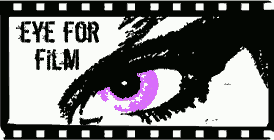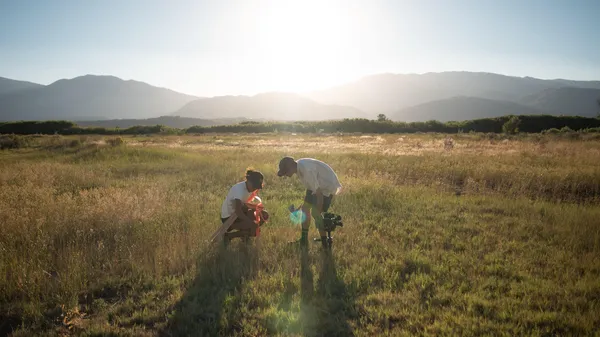 |
| Remaining Native |
Ku Stevens of Yerington Paiute Reservation is a teenage long distance runner with his heart set on a scholarship programme in Oregon. His great grandfather, Frank Quinn, was also a runner of sorts – as an eight-year-old child he escaped incarceration in a reform school and ran 50 miles back to his home – more than once. Their stories intertwine in documentary Remaining Native, which is screening as part of this year’s South by Southwest.
I was supposed to be meeting the film’s director, Paige Bethmann, and producer Jessica Epstein, a month before the festival, but illness got in the way. Before we reconvened, an article I wrote for another publication on the subject of the US history of forced sterilisation went viral. I was surprised by the reaction to it, I told Paige, because it was only then that I realised how many North American have no idea that these things happened – indeed, are still happening in some cases – nor about their countries’ treatment of Indigenous peoples. Being Haudenosaunee, that lack of awareness was not a surprise to her.
 |
| Paige Bethmann |
“It's really hard because our people, Native people, have known this history forever.” she says. “When all the news came out about the unmarked graves in Canada, there was a big reaction from folks who are not Native being surprised, saying ‘Oh, I didn't know that happened in the United States or Canada.’ And it can be frustrating to feel like people know your history and it's exhausting to sometimes have to catch people up. You know, you can't just start at the boarding school. You have to sometimes start at 1492. It can be really energy-draining on that front. But the way that I wanted to approach the film was really not for people to get caught up to speed. It was really meant to try to incite emotions and to get people to be curious enough to want to educate themselves and to Google it if they didn't understand the full history.
“For me, the purpose of the film was really to have indigenous people feel seen and their histories acknowledged and to be able to provide that space to reflect and share a story that’s so personal to Ku and his family through this lens of an eight-year-old child. And hopefully by doing that, other people would be like, ‘Wow, this experience of an eight-year-old child let me just emotionally connect to that and I can look further into the history.”
I ask if she thinks that when there's a personal connection, as in the story of Ku, people find it easier to take on such a big subject, rather than thinking that it's too much and it's not realistic if they don't know the history to begin with.
“I think that with the approach of the film, starting with Ku and having him be welcomed in the film as an athlete, and really get to know his goals and his dreams and his family, you automatically are like, ‘Okay, I want to cheer for this kid,’” she says. “And then it unravels into the historical the more personal story of his family. It was a way to track people, but now it's a way to almost have a Trojan horse experience where you're watching this film about this athlete, but then you're also subtly interweaving the really, really strong realities of our history and the families who are impacted by that. I think people care about people and I think when they see someone that they can relate to or they admire or they want to get to know better, then they'll take more time to listen and want to understand them better.”
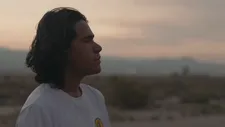 |
| Remaining Native |
How did they connect with Ku?
“I relocated from New York City to Reno, where I am right now, to be with his family, to be with the community, to show up in spaces without a camera to make sure that I could get to know this 17-year-old kid because he's not going to call me and tell me what he's doing. And you know, every time we fly in and fly out, you have to almost start over again. I really didn't want to have to feel like I was parachuting in and out, especially when navigating really sensitive topics like his grandfather's story and just like being what it means to be a young person today with all the things and all the changes going on.
“I think by staying here that relationship with him was able to develop to a point where he's like my little brother. He would come and like crash on our couch in our apartment and play video games and eat all of our food, and I would go fishing with his family. Trust was built that way, of being able to have conversations openly and being able to say ‘I actually don't want you to film my high school prom.’ Okay, no worries. I won't do that. Or, you know, ‘Can we make space to bring up that interview question later?’ You know, there was just time to be able to understand exactly like how he was feeling and give him the grace of being a 17-year-old kid in that same space.
“In regards to the story, we didn't know if he was going to make it to his dream school, but for me it wasn't so much about whether or not he made it to Oregon. It was really more about his understanding of how his community coming together to support him is something that he's going to be able to carry with him that, like this history and this story of his great grandfather, isn't something that's going to hold him back or be this burden that's going to be on him emotionally. Yes, it is going to be heavy, but it's something that he can carry forward and use as power and energy.
 |
| Behind the scenes with Ku |
“We spent a lot of time trying to figure out how to interweave these things together structurally in the film. It took a long time. It was like, ‘Well, why is the story coming up now?’ And we were just like, ‘You know, why do I have to provide justification?’ I think for me, when Ku's running on the land, that's the moment when these stories are unearthed. It's as simple as that. Our land holds our stories, and so when he's connecting, especially as a distance runner and training out there for so long, it brings you into a more meditative and thoughtful state.
“We thought that was a great opportunity to bring up the stories of his great grandfather. And then finding the ways that those interweaved with the sports story, we were kind of, you know, here's Ku's attempts to get this under nine minutes, two miles. And then, here are the three escapes of his grandfather. That's when they converge. Understanding that, he was able to tap into this ancestral muscle memory to push him further in his career.”
It does also seem challenging to him. There's a moment in the film where he worries that he hasn't achieved enough with his life - and he's 17.
“It’s heartbreaking,” she says. “It's just like that feeling of emptiness. I feel like so many athletes can relate to that in so many ways, and the same with other people who are after such huge goals. I remember an interview with Viola Davis, finally winning the Oscar. She felt heartbroken after she received it. It's like a feeling of emptiness. And I think for Ku, there were moments when he was like, ‘I'll never be satisfied.’ It's kind of that mentality there. But I think he really felt this responsibility and this motivation to honour the story of his great grandfather, especially with what had just happened, with all the news coming out. And he felt like he had this platform to be able to run and do exactly what his great grandfather did over that landscape and to try to invite everyone together to do that.
“I think it really was healing for him. I think he hadn't necessarily discussed how he was feeling with other people about the boarding schools, other than his family. And so to be able to cultivate that space with the run, I think, gave him this hope that he is doing something with purpose and that it's not just about getting into Oregon and saying goodbye. It's like realising and reflecting that his community is what got him there.”
 |
| Remaining Native |
Going back to what she was saying about the land, I note that early on in the film, Ku mentions how he imagines a land that's full of sagebrush. How much has the landscape that he runs through changed?
“It has changed a lot,” she says. “There's mining in Nevada, a lot of extraction. Especially now, they're looking at sites for lithium that are going to be right on tribal lands here. A lot of copper mining, which was a big one in Nevada, especially in this area. It really carved the landscape and the roads that were built and a lot of agriculture and farming. So the land has changed quite a bit. But it's so interesting because when you run the 50 miles, you do get to areas that feel completely untouched, and it's almost like the before times and you start seeing the lights. And that's in the high desert.
“It’s the most unique place I've ever been because it's dry and hot and you would think that everything would just be brown, but there's so many colours and it's green and there's different types of animals and the pine nuts that grow in the higher altitudes and the different birds that are eating those pine nuts. It feels very protected in that way, even spiritually. It is hard, though, sometimes when you're driving down to where Ku lives. He lives about an hour south of me. You drive through all the heavy industry. Amazon has warehouses here, Tesla has their factory here, and you see the harm that's being done on the land. It makes you kind of sick.”
I ask about the selection of archive photos in the film. There's one sequence where we see a number of different photos which show the stages of people becoming more white-assimilated in the school, and then there's an amazing photo later on where we see row upon row of children who've been through that process.
She nods. “Yeah. The Stewart Indian School. Now it's a cultural centre and museum. It was here for 90 years, so from 1890 to 1980, and there are a lot of survivors of that school here, and they have a repository of archived photos. They gave them to us to go through and use for this film. I wanted to be really intentional when it came to the timing of when those photos were, when they were taken. Because over time, especially in Stewart, the school changed. They became more accepting. A lot more indigenous people willingly went to the school, and it’s a place where people call themselves alumni. There's a generation where you're called survivors, and there's a generation that you're called alumni.
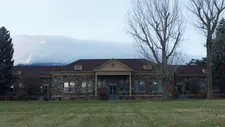 |
| Stewart Residential School, now a cultural centre. |
“I wanted to be as close as I could to the time frame of when Ku's great grandfather was going to be in that school, which was around, 1910. A lot of the selection of the archive was during that time. I think the photos, they're so haunting because they are shot through the lens of a white man, and they are proud of posing these children, they're proud of what they're doing. They are using those photos as propaganda to share out to the wider area to say ‘We are saving these children. Look at their transformation from savages to white men.’ I really wanted to find – how do we get the agency back to these kids? How do we get closer in the photographs to really try to capture emotion or intentional decisions or eye contact? How are we directing eyes to different photographs or even different things, to build these stories within the photos themselves?
“It's not shocking, but it's also just like, ‘Wow, you're really putting the evidence out here.’ You know, this is just the truth. And I think for us, we really wanted to maintain the integrity of the photos and not put any motion graphics on them, not enhance them in any way, because these are primary source photographs. And I think the long pan one, you know, we found that photo pretty late on, and I was like, ‘Wow, they took the time to find a photographer back then who can make a panoramic photo of that size.’
“The amount of time, just thinking about how that photograph was taken, to pose everybody, to get everyone lined up and to go through and settle in and try to look at every single face by going through the pan – my intention was to show this was the scope. We showed you a lot of individual selections of photographs in the film. Now here's the full scope of how many were there at one time and thus their expressions. And it was hard looking at that stuff all the time. Though I will say that Jess played a big role in helping to go through the archive and taking breaks and trying to create some distance as well, because it's really heavy looking at them all the time.”
 |
| Remaining Native |
“Making an independent film is a labour of love,” says Jess. “The way that we've been able to create this film is through collective action and support. It's through a number of artist development programs. Tracy Rector runs an incredible program called 4th World Media Lab that Paige was able to participate in. She's on the Media Maker Fellowship. We had incredible experiences at the Points North Institute over two years, and all of those experiences not only supported us as artists and creators, but opened doors for us that we hadn't had access to.
“Paige and I have both been in this field for many years, but working in the independent space is pretty different. And so opening up those opportunities not only for the industry folks, but for are our peers, I think that we've found family, we've found community. These are people we turn to. They've supported us, and we continue to support them. We're incredibly grateful to all of our funders, our peers, our sponsors. We've also been able to get some really awesome partnerships and support of the film, like Sigma. And it's really been a collective and collaborative effort, largely driven by Paige's vision for reciprocal partnerships.”
Am I right in thinking that financing is finally beginning to get easier for Indigenous film, at the same time as filmmaking itself is getting more affordable?
“Definitely,” says Paige. “I'm not sure if it's easier, but I do think that there's more opportunities to be able to take more chances and to be able to turn to different places to try to get that support. A lot of the fellowship programs and grants, they really help cultivate community. For me, it's like the cohorts and places I've been have been the reason why I keep making those attempts and keep trying to find those opportunities. Because it's really draining to constantly be turned away or told ‘This is too niche,’ or ‘This is too sad,’ or whatever it is, or ‘This is too hard to explain because people don't know the history.’ There's so many people in power who aren't familiar with Indigenous voices and don't know what to expect, and therefore sometimes they don't want to take the risk, you know?
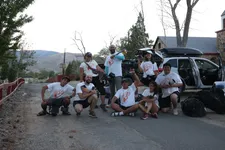 |
| The Remaining Native team |
“It's becoming easier to find more community, especially in talking with other Indigenous artists, to have that support system and to be the connectors to different resources. And, you know, a lot of conversations are ‘Oh, I got in touch with this funder and I think you should reach out as well,’ and trying to make those connection points and access the fund. But it still takes the same amount of work. I think there are people who are paving the way, like Tracy, who say ‘I'm going to extend my arm and pull everyone forward with me.’ There's momentum to break down some of those barriers, and that feels really exciting. I think people are starting to see the power of Indigenous groups’ film and how it is connecting topically to what is happening in this current world.”
There's obviously a lot of fear at the moment among a whole lot of different historically marginalised people in the US about what's happening there. But at the same time, it feels to me that culturally, some people are opening up a bit more and there's more interest in these stories amongst the wider public. Do they think that's the case?
“I do,” says Paige. “I mean, the work and the stories that we have have always been there. They're not new ideas. I mean, they're creatively new ideas, but I think there's this really powerful thing that's happening where a lot of our stories contain a lot of the solutions to what we're doing in this world. How are we cultivating better relationships with land? How are we sharing stories about connection to place that people are really attracted to? Because I think they want to understand their own connection. They're seeing things that are harming the land, and they want to figure out a solution to how we address climate change. I think it starts with, how do we have a better relationship within ourselves to a place? And I think a lot of indigenous stories hold that.
“There's a saying that I've heard: our elders have the visions but the young people have the dreams. And so when the elders share their stories, they're talking about places that they've seen that they know can be abundant, that they know that are clean, like clean water and not deforested land and places that are thriving. Without them telling us what that looks like, we don't know what to strive for. How can we strive towards a clean water system if we never know what that looks like? To be able to build stories around some of those visions, I think helps us have more hope and leads us to a place where we can maybe get there one day.”
 |
| The long road to freedom. |
She has plenty of stories to tell herself, going forwards.
“I want to keep making films and I want to make an experimental film about maple syrup.” She smiles, but she’s serious. First things first, though. “We have a lot of work to do with this project. We have a lot of impact work that we're doing with the community. We want to go on a rez tour to make sure that this film is out there in the community. We’re doing things with VR, with the remembrance run, so elders who didn't get to come out on the run can have an opportunity to experience it virtually. And an educational curriculum to combat this idea that people just don't know the history. We want to make sure that we're creating curriculum for people to understand it, but also for Native kids who may be just trying to unpack what they already know. To be able to have a curriculum that opens up discussions and can start at a deeper place than just what happened. But how is it socially impacting our daily lives on those levels? So, yeah, we have a busy two, three, five years.”
“One of the partnerships that we've had over the last few years is with Running Strong for American Indian Youth,” says Jess. “Billy Mills is the co founder of that organisation. And we came to it because Ku went through one of their programmes. Paige is also working on some short films that are for that organisation and uplifting some of the additional young people who have come through the Dream Starter programme. So we have our work cut out for us.”
